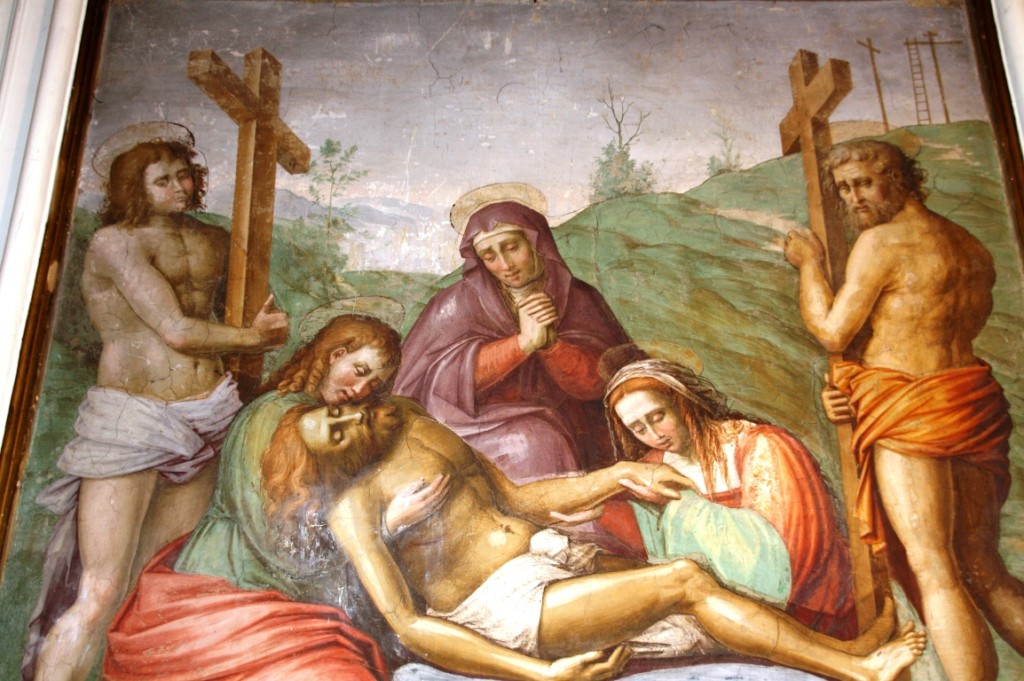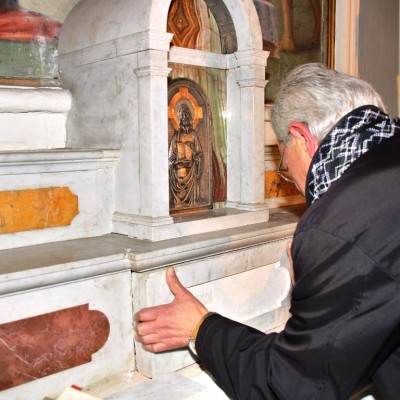The news came quietly, leaving the art world stunned to learn that a fresco in the church of Santa Maria in Marcialla, not far from Florence, had been attributed to none other than Michelangelo.
Residents of Marcialla, a tiny village south of Florence, have claimed for generations that Michelangelo created a fresco in their local parish church of Santa Maria depicting the deposition of Christ. Dedicated study by numerous art experts and historians made the attribution official; Michelangelo, along with the probable assistance of two of the artist’s friends — Granacci and Bugiardini — created the fresco. The two associate’s intervention, as well as some more recent overpainting, complicated and delayed the attribution.
The discovery of initials — MFB — hidden for centuries behind the altar facade in the church’s side chapel provided one of the most important pieces of evidence to support the attribution. Historians believe the letters either stand for Michelangelo Buonarotti Fecit or Michelangelo Buonarotti Fiorentino (Michelangelo Buonarotti did this or Michelangelo Buonarotti of Florence). The fact that the letters “M” and “B” were the same as those the artist painted above a crucifix in the church of Santo Spirito in Florence provides additional evidence supporting this attribution to Michelangelo
The local parish priest, Father Rosario Palumbo, shared with Dottoressa Elsa Masi, a local resident and retired chemist, that he had overheard a parishioner talk about seeing the initials behind the chapel’s altar stone many years prior during a youthful prank.
Dottoressa Masi has led efforts to achieve formal attribution of the fresco, regardless of result. She reached out to the expert Renaissance art history community to have this important piece of news investigated.
Further data points confirm Michelangelo’s hand; in the winter of 1494, the artist sought refuge with the Augustinian monks who lived and worked in the Marcialla church and monastery. The ‘mad monk of Ferrara’, Domenico Savonarola, had ousted the Medici from Florence. To avoid becoming entangled in the political and social turmoil surrounding anyone associated with the Medici, Michelangelo fled. Michelangelo may have created the fresco as a way of thanking the Augustinian monks for their hospitality and protection. The Order would later support Michelangelo’s anatomical studies in underground rooms beneath the Basilica of Santa Croce in Florence.
Some conjecture suggests the figure on the right in the fresco, a muscular bearded man, represents Michelangelo’s imaginative interpretation of his own aged face. Compared to the face of Nicodemus in the artist’s sculpture of the Pieta, now displayed in Florence’s Museum of the Works of the Duomo, as well as numerous etchings and paintings of the artist in his old age, there are certainly arguments to be made.
The body of the artist’s work favors the triangular form of the main figures seen in the fresco. Additionally, and also not unknown in Michelangelo’s work, a depiction of Joseph, the father of Christ, is absent from the fresco.
Professor Robert Weiss, in his 1942 book, The Renaissance Discovery of Classical Antiquity, makes the assertion that the fresco was Michelangelo’s. Then, the fresco slipped back into its quiet corner of a small church in rural Tuscany — until now. After years of tireless work, the art’s community has made it official: Michelangelo is the artist who created the fresco.
I always find it surprising, and a stunning statement about hidden treasures of art, to learn of yet another masterpiece by a Renaissance genius on the side altar of a small church, in a small village, in the hills of Tuscany.
Please enjoy this short video to learn more about this hidden treasure in the heart of Tuscany.
IF YOU GO:
The village of Marcialla rests about forty minutes south/southwest of Florence. This lovely village is ‘off the map’ of the heavy tourist traffic, making it all the more enticing as a day excursion destination.
Please call the church office before visiting; you will need to confirm the church is open for visitors.
Piazza Antonio Brandi, 25, 50021 Marcialla FI, Italy
Tel: +39.055.80.74.105





